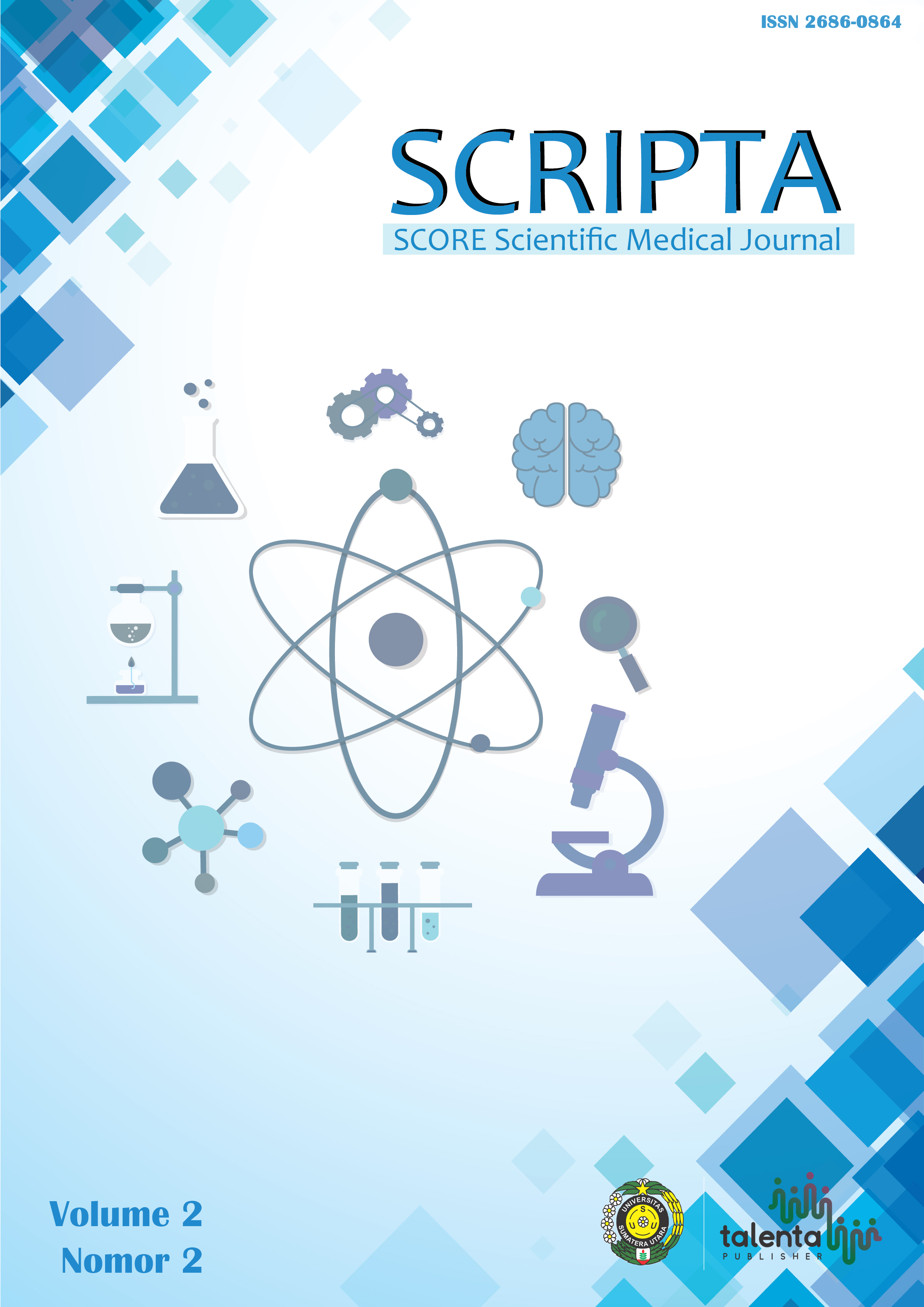Stroke Large Vessel Occlusion pada Serologi COVID-19 Positif
DOI:
https://doi.org/10.32734/scripta.v2i2.4646Keywords:
coagulopathy, COVID-19, large vessel occlusion, koagulopatiAbstract
In December 2019, severe acute respiratory syndrome coronavirus 2 (SARS-CoV-2) appeared and caused COVID-19 in Wuhan, China. Of the 329 cases of COVID-19, the most common type of stroke was large vessel occlusion/LVO (31.7%) compared to small vessels (15.3%). A 73 year old man came in with weakness on the left side of his body since the day before after farming. Initially, the left leg felt limp, so the walk was limping, then the left hand seemed to be bent and could not be straightened. The head feels throbbing pain in the whole head. He had dysarthria since yesterday and when drinking, the patient chokes. His activity so far has only been farming near his house and he said there was no contact with people with fever or colds. He has a history of hypertension and is already taking Candesartan 8 mg every morning. Physical examination showed a blood pressure of 152/78 mmHg, pulse rate of 58 times per minute, respiratory rate of 20 times per minute, temperature of 36.8 oC, and 99% oxygen saturation with room air. Physical examination showed paralysis of seventh, tenth, and twelfth left cranial nerve. The muscle strength of the left hand and left leg is 2 out of 5, while the rest is normal. Eyeball movement is still possible, but both eyes often deviate to the right. Investigations for the results of random blood sugar, blood creatinine urea, and electrolytes were normal. The first day of chest X-ray showed calcification in the aorta and no infiltrate. On the fourth day, there were infiltrates to the periphery in both lung fields. This patient was diagnosed with LVO with acute infection and coagulopathy of COVID-19.
Keywords: coagulopathy, COVID-19, large vessel occlusion
Â
Pada Desember 2019, severe acute respiratory syndrome coronavirus 2 (SARS-CoV-2) muncul dan memicu COVID-19 di Wuhan, Cina. Dari 329 kasus COVID-19, jenis stroke tersering berupa large vessel occlusion/LVO (31,7%) dibanding small vessel (15,3%). Seorang pria berusia 73 tahun datang dengan kelemahan pada sisi kiri badan sejak sehari sebelumnya setelah bertani. Awalnya kaki kiri dirasa lemas, sehingga jalannya pincang, lalu tangan kiri tampak menekuk dan tidak dapat diluruskan. Kepala dirasa nyeri berdenyut pada seluruh kepala. Bicara pasien pelo sejak kemarin dan bila minum, pasien tersedak. Aktivitasnya selama ini hanya bertani di dekat rumah dan mengaku tidak ada kontak dengan orang demam atau batuk-pilek. Dia memiliki riwayat hipertensi dan sudah mengonsumsi Candesartan 8 mg setiap pagi. Pemeriksaan fisik didapatkan tekanan darah 152/78 mmHg, laju nadi 58 kali per menit, laju pernapasan 20 kali per menit, temperatur 36,8 oC, dan saturasi oksigen 99% dengan udara ruangan. Pada pemeriksaan fisik tampak parese N. VII, X, XII sinistra. Kekuatan otot pada tangan kiri dan kaki kiri sebesar 2 dari 5, sementara yang lainnya normal. Gerakan bola mata masih dapat dilakukan, namun kedua mata sering deviasi ke arah kanan. Pada pemeriksaan penunjang didapatkan hasil gula darah sewaktu, ureum kreatinin darah, dan elektrolit normal. Foto thorax hari pertama tampak kalsifikasi pada aorta, tidak ada infiltrate dan pada hari keempat tampak infiltrat hingga ke perifer pada kedua lapang paru. Pasien ini didiagnosis LVO akibat infeksi akut dan koagulopati COVID-19.
Kata Kunci: COVID-19, koagulopati, large vessel occlusion
Downloads
Downloads
Published
How to Cite
Issue
Section
License
Copyright (c) 2021 Wilson Saputra Wijaya, Mohammad Ridho Devantoro, Hayyu Ari Anggriani

This work is licensed under a Creative Commons Attribution-ShareAlike 4.0 International License.
Authors who publish with SCRIPTA SCORE Scientific Medical Journal agree to the following terms:
- Authors retain copyright and grant SCRIPTA SCORE Scientific Medical Journal right of first publication with the work simultaneously licensed under a Creative Commons Attribution-NonCommercial License that allows others to remix, adapt, build upon the work non-commercially with an acknowledgment of the work’s authorship and initial publication in SCRIPTA SCORE Scientific Medical Journal.
- Authors are permitted to copy and redistribute the journal's published version of the work non-commercially (e.g., post it to an institutional repository or publish it in a book), with an acknowledgment of its initial publication in SCRIPTA SCORE Scientific Medical Journal.














